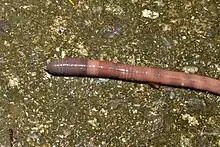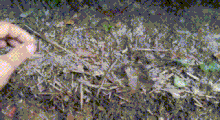Amynthas
Amynthas is a genus of earthworms in the family Megascolecidae.[1] They are known as jumping worms, snake worms, or crazy worms because of their erratic thrashing behaviour when disturbed.[2][3][4][5] The genus is native to East Asia, but they are invasive in many areas of the United States.[3][5][6] They are a matter of concern in many states, as they disrupt the native forest ecology by affecting soil structure and chemistry.[3][7]
| Amynthas | |
|---|---|
 | |
| Amynthas aspergillum (Taiwan) | |
| Scientific classification | |
| Domain: | Eukaryota |
| Kingdom: | Animalia |
| Phylum: | Annelida |
| Class: | Clitellata |
| Order: | Opisthopora |
| Suborder: | Lumbricina |
| Family: | Megascolecidae |
| Genus: | Amynthas Kinberg, 1867 |

Appearance
Amynthas species can be differentiated from other earthworms by their clitellum, which is pale, annular, is close to the head, and lies flat against the body.[3][8] They vary in size between 3.8 and 20.3 cm (1.5 and 8.0 in).[8][9]
Life cycle
Amynthas species' faster reproduction rate and their ability to reproduce asexually (parthenogenesis) has contributed to their spread into the United States.[10] The worms reach maturity in 60 days, which allows them to have two hatches per year.[10] Eggs are wrapped in small cocoons, which overwinter while the adults die off. The young then emerge the next spring.[11]
Species
- Amynthas agrestis (Goto and Hatai, 1899)
- Amynthas alexandri (Beddard, 1900)
- Amynthas assimilis (Hong & Kim, 2002)
- Amynthas borealis (Panha & Bantaowong, 2011)
- Amynthas comptus (Gates, 1932)
- Amynthas defecta (Gates, 1930)
- Amynthas dorualis
- Amynthas exiguus (Gates, 1930)
- Amynthas fucosus (Gates, 1933)
- Amynthas gracilis (Kinberg, 1867)
- Amynthas hilgendorfi (Michaelsen, 1892)
- Amynthas hupbonensis (Stephenson, 1931)
- †Amynthas japonicus (Horst, 1883)
- Amynthas kinmenensis
- Amynthas longicauliculatus (Gates, 1931)
- Amynthas luridus (Shen, Chang, & Chih, 2019)[12]
- Amynthas mekongianus (Cognetti, 1922)
- Amynthas minimus
- Amynthas mirifius
- Amynthas moakensis
- Amynthas morrisi (Beddard, 1892)
- Amynthas mujuensis
- Amynthas obsoletus
- Amynthas papulosus (Rosa, 1896)
- Amynthas phatubensis (Panha & Bantaowong, 2011)
- Amynthas polyglandularis
- Amynthas pulvinus
- Amynthas ruiyenensis (Shen, Chang, & Chih, 2019)[12]
- Amynthas sangumburi
- Amynthas siam (Blakemore, 2011)
- Amynthas srinan (Panha & Bantaowong, 2011)
- Amynthas taiwumontis
- Amynthas tessellatus
- Amynthas tokioensis (Beddard, 1892)[12]
- Amynthas tontong (Panha & Bantaowong, 2011)
- Amynthas wuhumontis
- Amynthas wujhouensis
References
- Bantaowong, U.; Chanabun, R.; Tongkerd, P.; Sutcharit, C.; James, S.W. & Panha, S. (2011). "New earthworm species of the genus Amynthas Kinberg, 1867 from Thailand (Clitellata, Oligochaeta, Megascolecidae)". ZooKeys (90): 35–62. doi:10.3897/zookeys.90.1121. PMC 3084491. PMID 21594106.
- "Asian Jumping Worms". hortnews.extension.iastate.edu. Retrieved 2022-12-21.
- "Jumping worm (Amynthas species) | Minnesota DNR". www.dnr.state.mn.us. Retrieved 2022-12-21.
- Silver, Jennie. ""Jumping Worm" – Amynthas spp". Extension Richland County. Retrieved 2022-12-21.
- "details". www.tsusinvasives.org. Retrieved 2022-12-21.
- "Amynthas Worms in Maine : Maine DACF". www.maine.gov. Retrieved 2022-12-21.
- "Jumping worms". extension.umn.edu. Retrieved 2022-12-22.
- Wisconsin DNR Forest Health. "Jumping Worms (Amynthas spp.) Fact Sheet". Updated April 2015. Accessed Dec 22 2022.
- "Jumping Worms". www.michigan.gov. Retrieved 2022-12-22.
- "Jumping Worm (Amynthas spp.)". Cornell Cooperative Extension. Retrieved 2022-12-22.
- weeks (2021-07-28). "Jumping/Crazy/Snake Worms – Amynthas spp". Center for Agriculture, Food, and the Environment. Retrieved 2022-12-22.
- Shen, H.-P.; Chang, C.-H. & Chih, W.-J. (2019). "Two new earthworm species of the genus Amynthas (Oligochaeta: Megascolecidae) from central Taiwan, with comments on some recent species assignments in Amynthas and Metaphire". Zootaxa. 4658 (1): 101–123. doi:10.11646/zootaxa.4658.1.4. PMID 31716758.